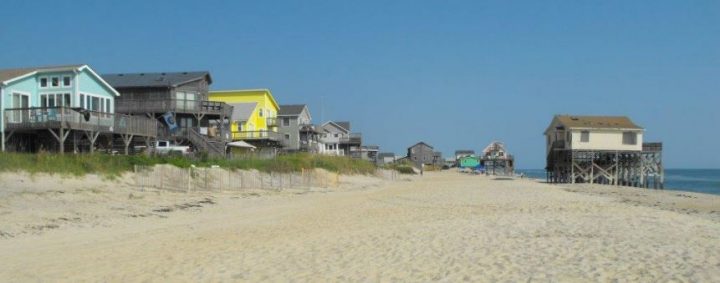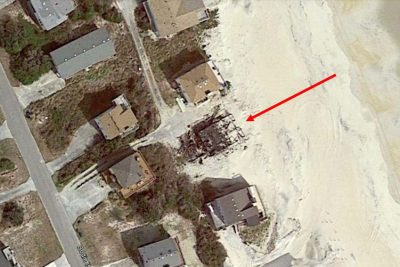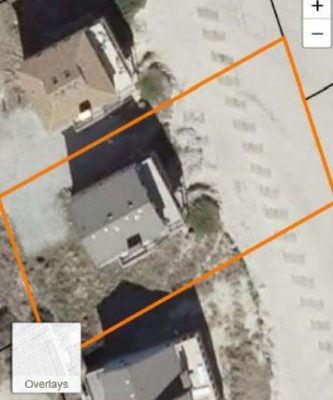
This story has been updated.
BEAUFORT – The state Coastal Resources Commission is expected to hold a closed-door discussion next week during its public meeting here to discuss a lawsuit pitting private property rights against state oceanfront setback rules, specifically as they pertain to a storm-battered, erosion hot spot on the Outer Banks.
Supporter Spotlight
The closed session to consult with the CRC’s attorney about the case is allowed under the state’s open meetings law. The remainder of the meeting that begins at 9 a.m. Wednesday at the National Oceanic and Atmospheric Administration’s Beaufort Laboratory/North Carolina National Estuarine Research Reserve Office, 101 Pivers Island Road, is expected to be open to the public.

The case involves Michael and Cathy Zito of Timonium, Maryland, who had tried to rebuild their vacation cottage on the lot they had owned since 2008 on Seagull Drive in Nags Head after fire destroyed it in 2016. State and local governments denied building permits because the replacement house planned for the same footprint as the two-story, piling-supported original built in 1982 wouldn’t meet state coastal setback requirements.
Homes on Seagull Drive have been the subject of years of legal fights over property rights. But unlike eight other Seagull Drive homes that have been destroyed by storms and erosion during the past decade, an electrical fire was to blame in the case of the Zito’s house. State officials contend that denying permits is necessary because allowing the Zitos to rebuild their home “would constitute inappropriately sited development.”
The Zitos filed the complaint March 6 in the U.S. District Court for Eastern North Carolina, naming the Coastal Resources Commission as defendant. They’re being represented by the Pacific Legal Foundation, a nonprofit formed to fight “government overreach and abuse,” and seek damages of $700,000 for the taking of their private property without just compensation, legal fees and other relief. Pacific Legal, which takes on property rights cases free of charge, says on its website that if the government wants to make private property useless so the public can enjoy it as open space or a beach area, it must pay the owners just compensation. It says the government shouldn’t use a natural disaster to justify cleansing an area of development it doesn’t like or want.

David Breemer is the senior attorney representing the Zitos. He said state officials never had a problem with the Zitos’ home being near the ocean before the fire, and the Coastal Resources Commission had no issue with other homes just as close or closer to the water than the Zitos’ lot.
Supporter Spotlight
“So the only risk the Zitos apparently had is apparently the unexpected one that the CRC would use the happenstance of a fire to get rid of a coastal home it otherwise must accept and has accepted as (a) normal coastal structure,” Breemer told Coastal Review Online Wednesday.
The property is designated as part of an Ocean Erodible Area of Environmental Concern, according to the state Division of Coastal Management, where the average annual erosion rate is 6 feet. Over the life of a 30-year mortgage, the ocean could be expected to carve out 180 feet of beach at the site.
Setback rules are geared toward “minimizing losses to life and property resulting from storms and long-term erosion, preventing encroachment of permanent structures on public beach areas, preserving the natural ecological conditions of the barrier dune and beach systems, and reducing the public costs of inappropriately sited development,” according to the division.

Rebuilding in the same spot means the southeast corner of the house would be about 12 feet landward of the static vegetation line, the setback delineation the state uses, and the northeast corner would be about 20 feet landward of the line.
Division of Coastal Management staff contend that while the property is located among other properties that don’t conform to current setback rules, that has no bearing on whether the Zitos face an unnecessary hardship – the basis for granting a variance from the strict application of the rules.
“For them not to be able to rebuild is just really tough for a lot of folks to understand,” said Cliff Ogburn, Nags Head’s town manager.
Ogburn said Wednesday that it’s especially hard to grasp when considering the two other houses in the same area that are closer to the ocean than where the Zitos’ house would be. That the Zitos lost their home through no fault of their own compounds the frustration. Ogburn said the Zitos would likely have many more years to enjoy their home if allowed to rebuild – as long as beach renourishment continues in the area.
“In my opinion, before it burned, the Zitos’ house would have a lot more life left in it than the other houses,” he said.
Although a beach renourishment project in 2010-11 offered some erosion relief in the Seagull Drive area, it was temporary – the vegetation line has since retreated landward and is now roughly where it was prior to renourishment, according to the Division of Coastal Management. The division says granting a setback exception would be inconsistent with the spirit, purpose and intent of the rules.

Ogburn agreed.
“The ill effect of allowing the Zitos to rebuild would be less than allowing the two houses that are farther seaward to remain, but the other ill effect is that if you have a property that doesn’t meet the setback requirements and it’s damaged beyond repair and if you let it go back, then you’re allowing the problems to persist,” Ogburn said. “This property doesn’t meet the setback and, in my understanding, that’s the deal breaker.”
Ogburn explained that since 2008, along that stretch of road, eight homes had been destroyed by storms and erosion. Only two houses remain on the east side of Seagull Drive and five more lots that may have had homes before that time had long been vacant. He said that no matter how unfair it may seem, the state’s coastal management rules exist for a reason, and the town, as the local enforcers of those rules, has much at stake.
“The town’s position has been pretty strong going back to the ’80s. We’ve been dealing with erosion for a very long time,” he said. “People here, at least since 1980 and beyond, they’ve seen the ocean was coming. We’ve been dealing with these houses on Seagull since at least 2008, and it hasn’t gotten any better.”
An attorney who represented the Coastal Resources Commission in the Zito’s variance proceeding, citing state policy, declined to comment on the ongoing litigation but noted that, in federal court, the state and its commissions must be represented by the attorney general’s office.
Other CRC Business
Also on the agenda for Wednesday, the commission is set to hold a public hearing on proposed changes to sandbag rules to allow more flexibility in using sandbags for erosion control around state port inlet areas.
A public comment period is scheduled for 11:45 a.m. The chairman may limit comments to three minutes per person.
Two requests for rule variances are on the agenda as well with one from Robert Stallings IV, who seeks to dredge in Pittman Creek, a primary nursery area in Pamlico County, to provide an access channel to a proposed upland basin with boat ramp and dock, and the other from the N.C. Department of Transportation, which seeks to use sandbags for erosion control at the northern ferry dock on Ocracoke Island.
The commission is to consider a fiscal analysis for a proposed rule change to allow a general permit for temporary structures within coastal shorelines and ocean hazard areas of environmental concern, or AEC, to accommodate scientific research needs.
The commission is also expected to consider a petition for rule-making to change the exceptions to nonwater dependent uses within the 30-foot buffer area of the rules for the coastal shorelines AEC by expanding the reference to “landscaping” to include the use of impermeable materials or “hard landscaping.”
The commission is also expected to hear reports on CRC science panel member appointments and discuss developing a rule to formalize criteria whereby structures and gear associated with a shellfish aquaculture leases are exempt from Coastal Area Management Act, or CAMA, permit requirements.








